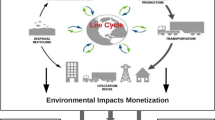Abstract
Due to growing public awareness, governmental regulations and concerns, environmental sustainability initiatives have received increasing attention among industrial decision-makers and practitioners. Employing environmental management programs can significantly minimize the waste and preserve the environment. However, papers have not much focused on exploring the interactions and interdependencies among environmental sustainability innovation factors, particularly in the context of manufacturing sector of emerging economies. To address this issue, this paper proposes a criteria decision framework, with the target of investigating the interactions among environmental sustainability innovation criteria within an emerging economy nation manufacturing sector context using Z-based DEMATEL technique. According to the findings, “designing products for being reusable and energy-efficient” is the most critical criterion and requires a considerable attention for successfully implementing environmental sustainability innovation. This paper significantly helps industrial managers and experts in emerging economies to better understand environmental sustainability innovation, employ environmental sustainability innovation practices in their supply chains and shift their industry toward sustainable development.
Graphic abstract



Similar content being viewed by others
References
Aboutorab H, Saberi M, Asadabadi MR, Hussain O, Chang E (2018) ZBWM: the Z-number extension of best worst method and its application for supplier development. Expert Syst Appl 107:115–125
Azadeh A, Saberi M, Atashbar N Z, Chang E, Pazhoheshfar P (2013) Z-AHP: a Z-number extension of fuzzy analytical hierarchy process. In: 7th IEEE international conference, pp 141–147
Bai C, Kusi-Sarpong S, Badri Ahmadi H, Sarkis J (2019) Social sustainable supplier evaluation and selection: a group decision-support approach. Int J Prod Res 57(22):7046–7067
Borsatto JMLS, Amui LBL (2019) Green innovation: unfolding the relation with environmental regulations and competitiveness. Resour Conserv Recycl 149:445–454
Carlile PR (2002) A pragmatic view of knowledge and boundaries: boundary objects in NEW product development. Organ Sci 13(4):442–455
Carter CR, Hatton MR, Wu C, Chen X (2019) Sustainable supply chain management: continuing evolution and future directions. Int J Phys Distrib Logist Manag 50(1):122–146
Chen YS, Lai SB, Wen CT (2006) The influence of green innovation performance on corporate advantage in Taiwan. J Bus Ethics 67(4):331–339
Chiou TY, Chan HK, Lettice F, Chung SH (2011) The influence of greening the suppliers and green innovation on environmental performance and competitive advantage in Taiwan. Transp Res Part E Logist Transp Rev 47(6):822–836
De Medeiros JF, Ribeiro JLD, Cortimiglia MN (2014) Success factors for environmentally sustainable product innovation: a systematic literature review. J Clean Prod 65:76–86
de Medeiros JF, Ribeiro JLD, Cortimiglia MN (2016) Influence of perceived value on purchasing decisions of green products in Brazil. J Clean Prod 110:158–169
de Vargas MG, Finocchio CPS, Barichello R, Pedrozo EA (2018) Sustainability and innovation in the Brazilian supply chain of green plastic. J Clean Prod 177:12–18
Gabus A, Fontela E (1972) World problems, an invitation to further thought within the framework of DEMATEL. Battelle Geneva Research Center, Geneva, pp 1–8
Govindan K, Jha PC, Agarwal V, Darbari JD (2019) Environmental management partner selection for reverse supply chain collaboration: a sustainable approach. J Environ Manag 236:784–797
Gupta H, Kusi-Sarpong S, Rezaei J (2020) Barriers and overcoming strategies to supply chain sustainability innovation. Resour Conserv Recycl 161:104819
Iles A, Martin AN (2013) Expanding bioplastics production: sustainable business innovation in the chemical industry. J Clean Prod 45:38–49
Kannan D, de Sousa Jabbour ABL, Jabbour CJC (2014) Selecting green suppliers based on GSCM practices: using fuzzy TOPSIS applied to a Brazilian electronics company. Eur J Oper Res 233(2):432–447
Kemp R, Arundel A, Smith K (2001) Survey indicators for environmental innovation (paper presented to conference “Towards Environmental Innovation Systems” in Garmisch-Partenkirchen)
Klewitz J, Hansen EG (2014) Sustainability-oriented innovation of SMEs: a systematic review. J Clean Prod 65:57–75
Kusi-Sarpong S, Gupta H, Sarkis J (2019) A supply chain sustainability innovation framework and evaluation methodology. Int J Prod Res 57(7):1990–2008
Lin H (2012) Cross-sector alliances for corporate social responsibility partner heterogeneity moderates environmental strategy outcomes. J Bus Ethics 110(2):219–229
Liou JJ, Yen L, Tzeng GH (2008) Building an effective safety management system for airlines. J Air Transp Manag 14(1):20–26
Lo HW, Shiue W, Liou JJ, Tzeng GH (2020) A hybrid MCDM-based FMEA model for identification of critical failure modes in manufacturing. Soft Comput 24:15733–15745
Luthra S, Mangla SK (2018) When strategies matter: adoption of sustainable supply chain management practices in an emerging economy’s context. Resour Conserv Recycl 138:194–206
Luthra S, Govindan K, Kannan D, Mangla SK, Garg CP (2017) An integrated framework for sustainable supplier selection and evaluation in supply chains. J Clean Prod 140:1686–1698
Mathiyazhagan K, Govindan K, NoorulHaq A, Geng Y (2013) An ISM approach for the barrier analysis in implementing green supply chain management. J Clean Prod 47:283–297
Mousavi S, Bossink B (2020) Corporate-NGO partnership for environmentally sustainable innovation: lessons from a cross-sector collaboration in aviation biofuels. Environ Innov Soc Trans 34:80–95
Murphy J, Gouldson A (2000) Environmental policy and industrial innovation: integrating environment and economy through ecological modernisation. Geoforum 31(1):33–44
Porter M, Van der Linde C (1995) Green and competitive: ending the stalemate. Dyn Eco-eff Econ Environ Regul Compet Adv 33
Saeed MA, Kersten W (2019) Drivers of sustainable supply chain management: identification and classification. Sustainability 11(4):1137
Shahzad M, Qu Y, Javed SA, Zafar AU, Rehman SU (2020) Relation of environment sustainability to CSR and green innovation: a case of Pakistani manufacturing industry. J Clean Prod 253:119938
Shen KW, Wang JQ (2018) Z-VIKOR method based on a new comprehensive weighted distance measure of Z-number and its application. IEEE Trans Fuzzy Syst 26(6):3232–3245
Silva GM, Gomes PJ, Sarkis J (2019) The role of innovation in the implementation of green supply chain management practices. Bus Strateg Environ 28(5):819–832
Silvestre BS, Ţîrcă DM (2019) Innovations for sustainable development: moving toward a sustainable future. J Clean Prod 208:325–332
Tariq A, Badir YF, Tariq W, Bhutta US (2017) Drivers and consequences of green product and process innovation: a systematic review, conceptual framework, and future outlook. Technol Soc 51:8–23
Tidd J, Bessant JR (2018) Managing innovation: integrating technological, market and organizational change. Wiley, New York
Todeschini BV, Cortimiglia MN, de Medeiros JF (2020) Collaboration practices in the fashion industry: environmentally sustainable innovations in the value chain. Environ Sci Policy 106:1–11
Toke LK, Kalpande SD (2019) Critical success factors of green manufacturing for achieving sustainability in Indian context. Int J Sustain Eng 12(6):415–422
Varadarajan R (2017) Innovating for sustainability: a framework for sustainable innovations and a model of sustainable innovations orientation. J Acad Mark Sci 45(1):14–36
Vasilenko L, Arbačiauskas V (2013) Obstacles and drivers for sustainable innovation development and implementation in small and medium sized enterprises. Aplinkos tyrimai, inžinerija ir vadyba 2:58–66
Wong WP, Tseng ML, Tan KH (2014) A business process management capabilities perspective on organisation performance. Total Qual Manag Bus Excell 25(5–6):602–617
Wu Z, Ahmad J, Xu J (2016) A group decision making framework based on fuzzy VIKOR approach for machine tool selection with linguistic information. Appl Soft Comput 42:314–324
Yaakob AM, Gegov A (2016) Interactive TOPSIS based group decision making methodology using Z-numbers. Int J Comput Intell Syst 9(2):311–324
Yang J, Han Q, Zhou J, Yuan C (2015) The influence of environmental management practices and supply chain integration on technological innovation performance—evidence from China’s manufacturing industry. Sustainability 7(11):15342–15361
Yew WL, Zhu Z (2019) Innovative autocrats? Environmental innovation in public participation in China and Malaysia. J Environ Manag 234:28–35
Zadeh LA (2011) A note on Z-numbers. Inf Sci 181(14):2923–2932
Zhu Q, Sarkis J, Lai KH (2012) Green supply chain management innovation diffusion and its relationship to organizational improvement: an ecological modernization perspective. J Eng Technol Manag 29(1):168–185
Author information
Authors and Affiliations
Corresponding author
Additional information
Publisher's Note
Springer Nature remains neutral with regard to jurisdictional claims in published maps and institutional affiliations.
Rights and permissions
About this article
Cite this article
Badri Ahmadi, H., Lo, HW., Gupta, H. et al. Analyzing interrelationships among environmental sustainability innovation factors. Clean Techn Environ Policy 24, 1191–1207 (2022). https://doi.org/10.1007/s10098-021-02086-z
Received:
Accepted:
Published:
Issue Date:
DOI: https://doi.org/10.1007/s10098-021-02086-z




